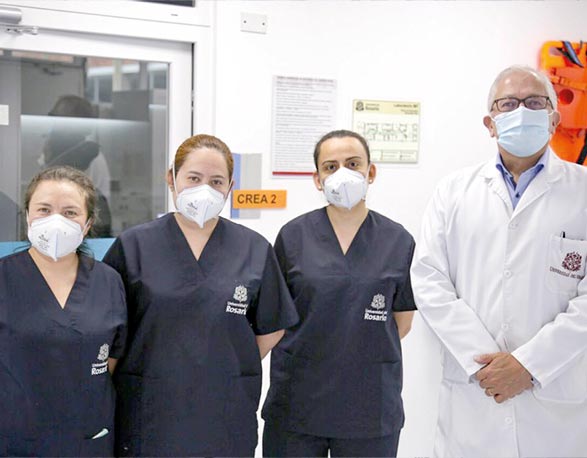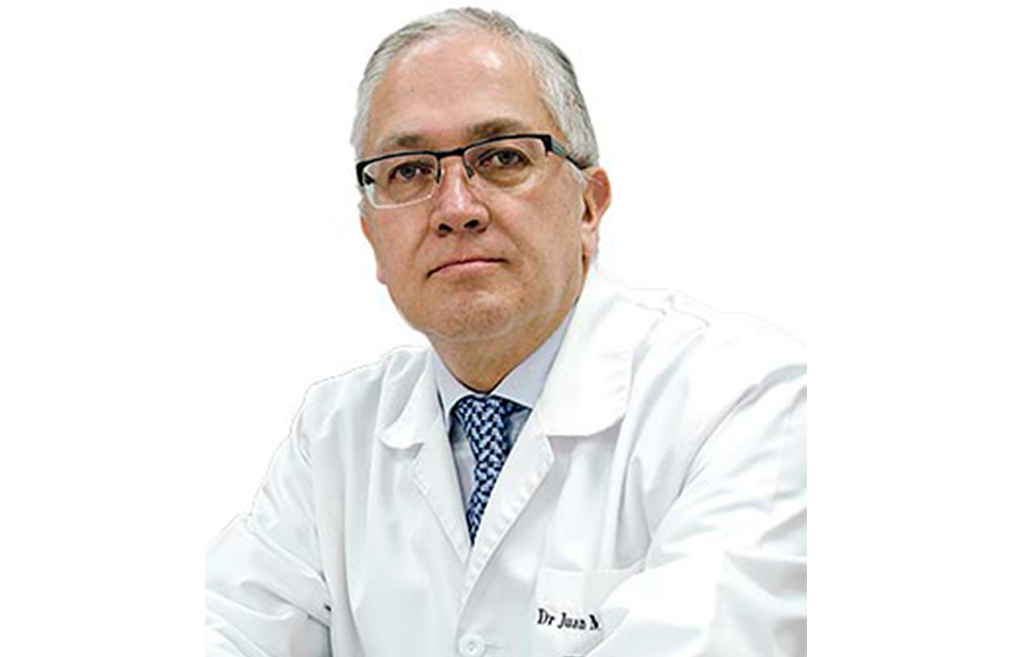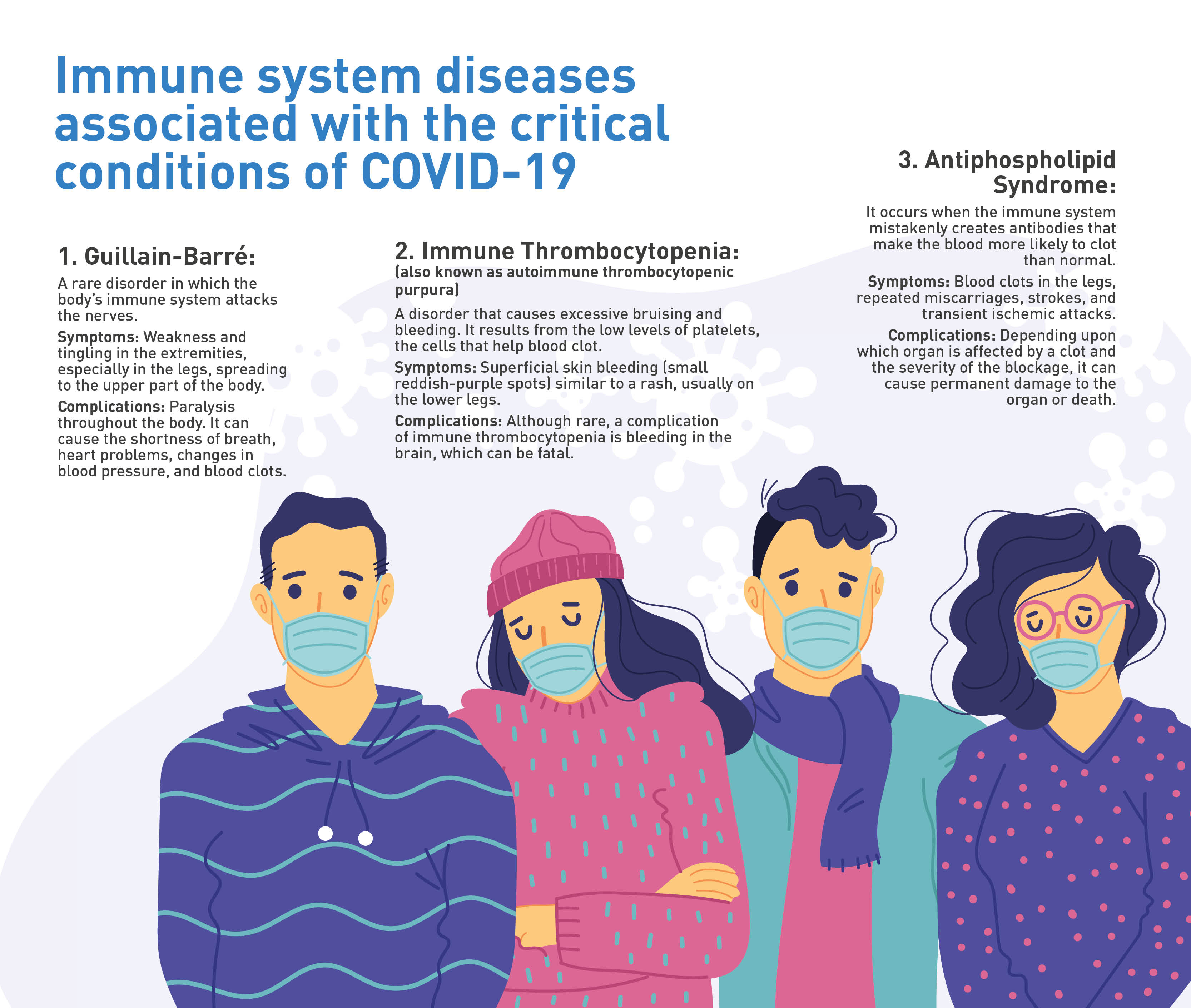In some cases, covid-19 turns our antibodies in our worst enemies
By: Tania Valbuena
Photos:
Health and Wellness

By: Tania Valbuena
Photos:
Often, the aggravation in the cases of this disease is due to comorbidity or preexisting medical condi - tions or to the degree of the patients’ vulnerabil - ity because of thexir age or other characteristics. Nevertheless, with the passing of time and a better understanding of the disease, we have learned that the immune system plays a strange role in certain scenarios.
Let us see: when we get coronavirus, there is an impercep - tible fight inside our bodies between our defense system and “the enemy.” In some cases, however, the virus can make this defensive army attack our own body.
To understand this phenomenon, a group of Colombian re - searchers from the Center for Autoimmune Diseases Research (CREA) at the Universidad del Rosario analyzed uncommon responses in a very small percentage of patients who died. In 2020, the cases of Guillain-Barre, Kawasaki disease, antiphos - pholipid syndrome, and autoimmune cytopenia, among other immune system disorders, were associated with the critical or severe cases of COVID-19.
The conclusions of the investigation Autoinflammatory and Autoimmune Conditions at the Crossroad of COVID-19 were published in Journal of Autoimmunity.
Correlation does not imply causality, but the progressive appearance and reporting of similar cases all over the world caught the attention of the Colombian team, formed by Juan Manuel Anaya, Yhojan Rodríguez, Manuel Rojas, Yeny Acosta Ampudia, Diana M. Monsalve, and Carolina Ramírez Santana. They decided to revise these episodes to understand not only what was happening with the defense system during a SARS-CoV-2 infection but also the connection between the virus and other autoimmune diseases.
This work, first of its kind, allows a better understanding of the details behind the aggravation of cases to improve available treatments and medicines.
Understanding the behavior of COVID-19
COVID-19 is a new disease: the World Health Organization classified it in November 2019, and it has disseminated throughout the planet in approximately a year and a half. Currently, the doctors who investigate it know that it can affect a person in different ways: the viral stage can be asymptomatic or mild in approximately 80 percent of the patients.
The remaining 20 percent may experience moderate symptoms that can worsen or become fatal (2–2.5 percent). Within this small group, there is a stage characterized by an excessive reaction of the immune system, followed or accompanied by a state of hypercoagulation (thrombosis), thus leading to organ injuries or death.
This description of the more complex stages of the disease is related to autoinflammatory and autoimmune conditions. “On the one hand, the immune system of most people works properly; on the other hand, the immune system of a minority ‘gets confused’ and generates a hyperinflammatory response, creating a cytokine storm and thus inflammatory signals,” Juan Manuel Anaya expressed to Advances in Science a Doctor in Biology, the Director of CREA and a member of the research group.
It is simple: what should be a defense of the body becomes a selfattack. It is as if the army of a nation attacked its own government and its own institutions, bringing them down and killing everyone.
Furthermore, it is highly probable that these patients will develop pulmonary thrombosis, causing damage to other tissues and organs or even the patient’s death. “It is the spectrum of COVID-19 symptoms,” said the academic. Nevertheless, there had never been a group analysis of the autoinflammatory and autoimmune conditions caused by the disease in cases all over the world.
New findings of the immune system reaction
The study revealed a review of the most relevant immunologic findings in the complex cases of COVID-19. The key concept is autoimmunity. Through this phenomenon, the body “attacks itself.” In a coronavirus infection, the immune system recognizes that the virus is not its own and generates an inflammatory response against it. In certain cases, this response not only attacks the virus but also the body, as in the cases of rheumatoid arthritis and lupus.

“This response caught our attention from the beginning of the pandemic,” explained Anaya who analyzed the work of colleagues from Rome, Milan, New York, and California based on the cases of autoimmune diseases that coincided with the coronavirus infection.
A high level of antibodies during a critical episode of COVID-19 requires more ventilation and implies a higher risk of death,” concluded Juan Manuel Anaya, a Doctor in Biology and the Director of CREA.
“This response caught our attention from the beginning of the pandemic,” explained Anaya who analyzed the work of colleagues from Rome, Milan, New York, and California based on the cases of autoimmune diseases that coincided with the coronavirus infection.
Revisamos las características de la enfermedad de Kawasaki, la comparamos con el síndrome multisistémico y pudimos ver sus diferencias y similitudes; además, notamos que estas enfermedades asociadas a COVID-19 tienden a presentar mayor compromiso cardiovascular”, detalló Anaya.
Among others, the following conditions were detected: Guillain Barre (autoimmune disease affecting the peripheral nerves), blood diseases such as autoimmune thrombocytopenic purpura (a disorder in which platelets are decreased) or hemolytic anemia (red blood cells are decreased), and antiphospholipid syndrome (thrombosis in any part). Another disease was the multisystem inflammatory syndrome in children, similar to the Kawasaki disease. In the literature of autoimmune diseases, the increase in cases was clear.
We revised the characteristics of the Kawasaki disease, compared it to the multisystem inflammatory syndrome, and could spot the differences and similarities. Moreover, we noticed that the diseases associated with COVID-19 tend to present greater cardiovascular compromise,” detailed Anaya.
Furthermore, in France, a team of scientists confirmed in October 2020 that the presence of antibodies against interferon (a molecule used by cells to defend themselves or respond to viral infections) predicted the deterioration of the COVID-19 case. “This would explain why sometimes the body can defend itself,” added the researcher named Anaya
Another advanced study from Spain detected the presence of antibodies against the ACE2 enzyme, a receptor for the virus, a response associated with the critical cases of the disease.
Finally, the most impressive discovery was the presence of countless antibodies related to autoimmune diseases in patients who did not even have such diseases at the moment of the study. “This is called latent autoimmunity, and it occurs when a person has an antibody (e.g., an antithyroid) but has normal hormone levels,” said the biologist and researcher
More cases were described by the Scientist, including hospitalized patients with COVID-19 that had rheumatological autoimmunity and highly specific rheumatoid arthritis antibodies. “However, none of the patients had arthritis. The worst part is that these antibodies carry a negative charge and are responsible for thromboembolic phenomena,” he said.
The higher the level of antibodies during a critical episode of COVID-19, the more ventilation is required and the higher the risk of death,” Anaya concluded.
Another job on the same track
Nevertheless, the group of researchers from Universidad del Rosario is not the only one studying these associations. Almost simultaneously, another study that has not been revised by peers yet (prepublication available at Medrxiv.org) concluded that in the severe cases of COVID-19, the production of antibodies that attack their own tissues (autoantibodies) is common.
The group in charge of this investigation, from Emory University in Atlanta (USA), analyzed the medical records of 52 patients with COVID-19 who were receiving intensive care. None had the records of an autoimmune disease. However, while the infection was still active on them, it was detected via a test that they had antibodies similar to those generated in a wide range of diseases.
The results were overwhelming. More than half of the 52 patients tested positive for autoantibodies. Additionally, of the patients with a higher blood levels of Creactive protein (a marker of inflammation), more than twothirds had indicators consistent with the fact that their immune system was producing autoantibodies.
Like the work of the Colombians, in the US prepublication, the data does not show to what extent these autoantibodies contribute to aggravating the most severe symptoms of the disease.
A very interesting aspect of this last work is that the tests to determine “autoreactive antibodies” were not specialized (they could be found in most American hospitals). In fact, they were the same as those used for standard rheumatology tests.
These observations, by both the Colombian and American teams, have crucial therapeutic implications if we consider that, to this date, the most promising candidates against COVID-19 are immunomodulatory drugs. Not only the doctors but also the groups developing current vaccines against the coronavirus must be aware of these conditions to provide personalized and effective treatments.
Challenges in the fight against COVID-19
For Anaya, immunogenicity is not the only pending issue in the fight against this pandemic. “We still need to work a lot at the level of the social appropriation of knowledge, medical care (early management is essential), a personalized treatment for each patient, the great challenge of vaccines and pharmacovigilance, and knowing everything about reinfection and post-COVID.”
At a time in which vaccines are scarce and transmission continues to follow its course in the country and worldwide, the experienced researcher concluded with a message for the general population: “There is no exaggeration in prevention.”
